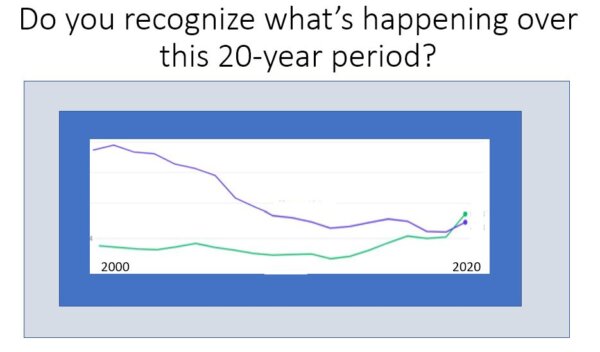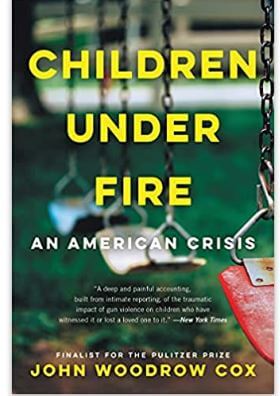
We’ve said before, awareness is a big part of being prepared. I think the information on this chart is something we all need to be aware of. Haven’t figured it out yet? Some hints:
- The lines reflect facts about children in the U.S..
- They trace causes of death from two sources.
- They show the new (since 2020) leading cause of death for children.
Those should be the clues you need! But to make it very clear: The purple line shows deaths of children (ages 1-19) over the past 20 years from automobile accidents. (Measured in deaths per 100,000 children).
The green line shows deaths of children 1-19 over the past 20 years from gun violence. (Again, measured in deaths per 100,000 children.)
In 2020, for the first time, firearms surpassed car accidents as the number one killer of kids in the U.S.
Of course, you may immediately question this data. Why doesn’t it include info for the past two years? What role did parents play in these deaths? How many gun deaths were accidents, homicide, suicide? Etc., etc. Where do other causes, like cancer, fit into this chart? If you’re interested in more detail, see my remarks and links at the bottom of the page.
To start with, let’s just consider the purple line killer.
The number of cars in the U.S. has continued to creep pretty steadily upward to around 276 million in 2020. More and more cars. More accidents, too. But the proportion of children dying in auto accidents has come pretty steadily down.
If I were to give you 60 seconds to come up with why, I am sure you’d say something like:
- Roadways are safer than ever: striping, passing lanes, barriers, signage, etc.
- Cars themselves are safer: mirrors, seat belts, warnings, anti-lock braking, etc..
- Driver behavior has been influenced by: licensing by age and type of vehicle, speed limits, DUI controls, etc.
O.K. I think we get what’s been going on with car safety.
Now let’s look at the green line killer in the chart.
The number of firearms has gone up just like the number of cars. (The rise is more dramatic, actually.) So why haven’t children’s deaths from guns gone down like they have for cars?
The answer is pretty obvious. No consistent improvements to gun safety. No consistent constraints on gun ownership and/or shooter behavior. I couldn’t even find two items to make a bullet list with!
Here at Emergency Plan Guide we’re interested in preparing for and managing or responding to emergencies – all kinds. We try to help people keep emergencies from turning into disasters.
Lately, as the leading cause of death, firearms have become a disaster if not a catastrophe for our children and their families.
What preparedness actions should we be taking against this threat? Which ones ARE you taking?
Virginia
Your Emergency Plan Guide team
Disclaimer: I am not an expert on car or gun safety. My Advisory is not meant to be a scientific report. But that doesn’t mean I wrote it off the top of my head.
I did a fair amount of research on everything mentioned here (and a lot on history and statistics I don’t mention). One thing I discovered . . easy data on both car and gun deaths is hard to come by. Below are some of the sources I found to be useful and I trust credible. But as you read them, or any articles on these topics, note the following:
- “Children” are defined differently in nearly every different report, whether produced by law enforcement, the insurance industry, government agencies, educators, etc. Be sure you are clear what’s being measured.
- “Deaths” are often sub-divided as to homicide, suicide, accidental and unknown. People dying may be killed by law enforcement, a family member, an acquaintance, or a stranger – and the statistics may or may not reflect the type of shooter.
Online sources I can suggest for automobile death statistics:
- https://injuryfacts.nsc.org/motor-vehicle/historical-fatality-trends/deaths-and-rates/
- https://www.statista.com/statistics/183505/number-of-vehicles-in-the-united-states-since-1990/
Sources on gun deaths and children:
- https://thehill.com/changing-america/well-being/longevity/3459995-guns-were-leading-cause-of-death-among-us-kids-in-2020-report-says/
- https://www.pewresearch.org/fact-tank/2022/02/03/what-the-data-says-about-gun-deaths-in-the-u-s/
And finally, a resource that I found truly compelling.
Research may provide you with statistics, but just as in the case of Paradise, another book I reviewed lately, what brings the issue alive are the stories of real people. Not the people who died, but the people who lived.

I recommend to you this book by John Woodrow Cox. It came out just last year and is a finalist for the Pulitzer Prize.
The New York Times says it is “a deep and painful accounting, built from intimate reporting, of the traumatic impact of gun violence on children who have witnessed it or lost a loved one to it.”
You can get Children Under Fire in a variety of formats including audio. Here’s the link to the book at Amazon, where we are Associates.
I believe that Ava and Tyshaun and LB and the other children’s desperate stories provide us with preparedness actions to consider. And now, we have to add to their stories the stories of all the Uvalde brothers and sisters. Certainly, that incident has raised even more questions and suggested more actions.
Don't miss a single Advisory.
Thank you for subscribing.
Something went wrong.
